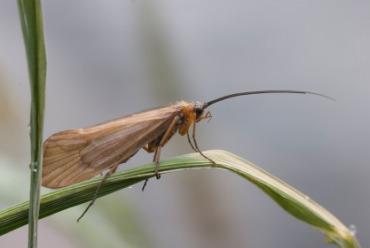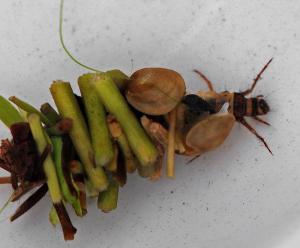We had our dinner outside last night. In the setting sun I noticed the glinting of a swarm of dancing insects. Pretty. Then they started dropping on my plate–while copulating. Hm. Not so pretty. What were these loving insects? Caddisflies.
A while back I wrote an article for the local newspaper about them. Here it is again for all you who might see this interesting phenomenon over the next few days.
If you have happened to be outside near a lake or river during the evenings this past week you might have noticed large swarming clouds of flying insects against the beautiful Berkshire sunsets.
 Don’t worry, they’re not mosquitoes, they are caddisflies. Caddisflies are not true flies, but moth-like insects that belong to the order Trichoptera. They do not bite. They merely imbibe in the sweet nectar of flowers. The reason we are seeing so many of them this time of year is that the synchronized emergence of adults being orchestrated by Mother Nature. These brown or grey winged caddisflies ranging in size from small to medium have spent months or years as aquatic larva eking out a living at the bottom of lakes or streams. They live in simple to ornate tubular houses made of tiny rocks and sticks sewn together with silk. Some even glitter with flecks of mica or pyrite. These shelters or cases are what give this order its common name of caddis, or ‘casemaker’. Inside these portable shelters the larva look like small hairless caterpillars with hooks on one end that they use to drag themselves around.
Don’t worry, they’re not mosquitoes, they are caddisflies. Caddisflies are not true flies, but moth-like insects that belong to the order Trichoptera. They do not bite. They merely imbibe in the sweet nectar of flowers. The reason we are seeing so many of them this time of year is that the synchronized emergence of adults being orchestrated by Mother Nature. These brown or grey winged caddisflies ranging in size from small to medium have spent months or years as aquatic larva eking out a living at the bottom of lakes or streams. They live in simple to ornate tubular houses made of tiny rocks and sticks sewn together with silk. Some even glitter with flecks of mica or pyrite. These shelters or cases are what give this order its common name of caddis, or ‘casemaker’. Inside these portable shelters the larva look like small hairless caterpillars with hooks on one end that they use to drag themselves around.
When they are ready to transform from the ugly little larva into the equally ugly hairy and warty winged adults, you can understand why it is not a magical transformation, but rather a slow restructuring of their biology. First a cocoon is spun inside the case.
 If you ever had a chance to see the pupa of a caddisfly, you would certainly think you were looking at an alien from outer space. The weird brown or green pupa have appendages that are not fused, but free to move about in the pupal case. The mouth has a special structure that looks like a weapon. It is long and thin and is used to keep debris from entering the case and later for cutting itself out of the cocoon.
If you ever had a chance to see the pupa of a caddisfly, you would certainly think you were looking at an alien from outer space. The weird brown or green pupa have appendages that are not fused, but free to move about in the pupal case. The mouth has a special structure that looks like a weapon. It is long and thin and is used to keep debris from entering the case and later for cutting itself out of the cocoon.
After two to three weeks of metamorphosis, the adult is ready to emerge. These caddisflies, suited in a pupal skin similar to a dry suit, swim to the surface of the water, using their six skinny not-made-for-swimming legs they flail about until they reach the top. That is if they reach the top. Fish and aquatic animals are on the look-out for these sumptuous graceless morsels and gobble them up by the hundreds if not thousands. If the caddisfly survives the perilous sprint to the surface, it can break out of the pupal case at the amazing speed of less than one minute and be ready to fly.
The first flight is short, usually to a nearby rock or plant to rest. Fly fishermen know the trick of using small nets stretched across the surface of streams catch these pupal sheds and identify which species is emerging and what type of fly they should use as a lure.
The swarming behavior we see taking place in the evening is a sort of a flying dance by the males to attract mates. The frenzied flight patterns of the males in these swarms are actually distinct cues to attract females of their species. After these insects mate along shores, the females make spumalin. No it is not a fancy wine, it is a sticky, gelatinous sugar for laying eggs in. The female uses this tacky substance to attached the eggs to rocks, plants or soil near the water. When the eggs hatch, usually within a few days, the larva fall into the water or the spumalin melts into the water and the cycle begins again.
These insects are biologically important because both the larva and adults serve as food to many fish and aquatic animals, as well as bats and birds. Because the larva feed on fine organic particles and small aquatic invertebrates that pass by them or are trapped in tiny nets they make between pebbles, they are very susceptible to pollutants in the water. So in turn, they are very good indicators of water quality.
